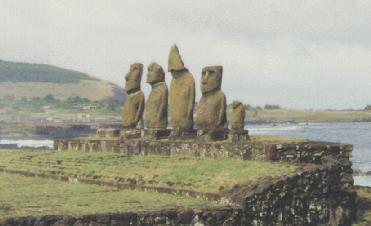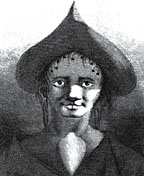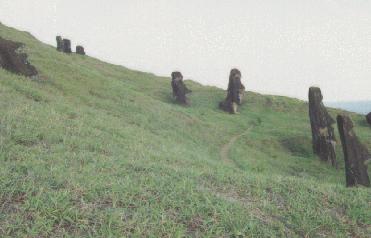
![]()
|
Darwin pointed out how groups of animals living in remote places eventually
take on unique characteristics and eventually turn them into distinct species.
Such is the case with the people of Easter Island. As unique as a culture
as they had become, the Rapa Nui left clues as to their origins in their
language, art, and beliefs. Contemporary archaeologists think it's an open
and shut case - the first and only people ever to live on Easter Island
were from an individual group of Polynesians that, once finding Easter,
then had no contact with any other races.
Until of course, that fateful day in 1722 when, Easter Sunday, when Jacob Roggeveen, became the first European to "discover" the island. What his crew witnessed and recorded once on the island has fuelled speculation about the origins of the Rapa Nui ever since. |
 |
| Who were the people? Well, around 1536, a Spanish ship, the San Lesmems was lost near Tahiti. Legends tell of the Basque survivors intermarrying with the Polynesians. Either they or their descendants set off from Tahiti to try and return home in the 1600's and were never seen again. Interestingly, genetic testing of pure blood Rapa Nui revealed the presence of Basque genes. | 
(above) This is a sketch made by Captain Cook's artist W. Hodges during his only visit in 1774 |
|
Thor Heyerdahl, a well known archaeologist and explorer was told by village
elders that the statues walked from the quarry to the ahu. While this seems
fanciful some have considered that it meant the statues where moved in
an upright position.
Several experiments were carried out and although it was proven that the statues could have been moved by rocking and rolling their bases similar to the way we would move a refrigerator or large piece of furniture, the method would have caused so much damage to the base of the statue that it would seem an unlikely method except when the statue was at the end of its journey and ready for final positioning. |
 |
| This is a method that we have thought of. Before you read it, remember that it is set in the past, so they won't have the modern technology like we have today! First, the building of the statues is to be done on top of a stone or something that can allow the people to pull the statues to the site they want to put it. After that, they will have loads of man-power needed to pull the statue and when it's at the desired site, they can just leave the statue there. This solution not only fits the elder's description on the statues 'walking' but is also quite logical, apart from the fact that a lot of manpower is needed. |  |
©2000 Myths & Mysteries of the World.All
rights reserved.
Unauthorised copying and manipulation is prohibited.